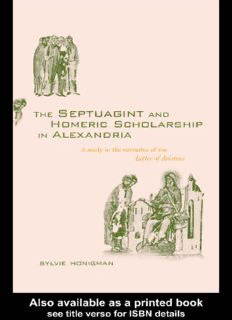
The Septuagint and Homeric Scholarship in Alexandria: A Study in the Narrative of the Letter of Aristeas PDF
Preview The Septuagint and Homeric Scholarship in Alexandria: A Study in the Narrative of the Letter of Aristeas
1111 2 3 4 5111 THE SEPTUAGINT AND 6 HOMERIC SCHOLARSHIP IN 7 8 ALEXANDRIA 9 1011 1 2 3111 4 5 6 7 8 9 20111 1 2 3 4 5111 6 7 8 9 30111 1 2 3 4 5 6 7 8 9 40111 1 2 3 44111 1111 2 3 4 THE SEPTUAGINT 5111 6 AND HOMERIC 7 8 SCHOLARSHIP 9 1011 IN ALEXANDRIA 1 2 3111 4 A study in the narrative of 5 the Letter of Aristeas 6 7 8 9 20111 1 2 Sylvie Honigman 3 4 5111 6 7 8 9 30111 1 2 3 4 5 6 7 8 9 40111 1 2 3 44111 First published 2003 by Routledge 11 New Fetter Lane, London EC4P 4EE Simultaneously published in the USA and Canada by Routledge 29 West 35th Street, New York, NY 10001 Routledge is an imprint of the Taylor & Francis Group This edition published in the Taylor & Francis e-Library, 2004. © 2003 Sylvie Honigman All rights reserved. No part of this book may be reprinted or reproduced or utilized in any form or by any electronic, mechanical, or other means, now known or hereafter invented, including photocopying and recording, or in any information storage or retrieval system, without permission in writing from the publishers. British Library Cataloguing in Publication Data A catalogue record for this book is available from the British Library Library of Congress Cataloging in Publication Data Honigman, Sylvie, 1965– The Septuagint and Homeric scholarship in Alexandria: a study in the narrative of the Letter of Aristeas/Sylvie Honigman. p. cm. Includes bibliographical references and index. 1. Letter of Aristeas. 2. Bible. O.T. Greek – Versions – Septuagint. I. Title. BS744.A7H66 2003 221.4′8′09–dc21 2003046663 ISBN 0-203-49877-1 Master e-book ISBN ISBN 0-203-57087-1 (Adobe eReader Format) ISBN 0–415–28072–9(Print Edition) 1111 2 3 4 5111 TO THE MEMORY OF 6 CHARLOTTE ERMAN 7 8 TO MY PARENTS 9 1011 1 2 3111 4 5 6 7 8 9 20111 1 2 3 4 5111 6 7 8 9 30111 1 2 3 4 5 6 7 8 9 40111 1 2 3 44111 1111 2 3 4 CONTENTS 5111 6 7 8 9 1011 1 2 3111 Preface and acknowledgements ix 4 List of abbreviations xi 5 6 1 Introduction 1 7 8 2 Genre and composition in the Book of Aristeas 13 9 20111 3 The central narrative: the transfiguration of history into 1 charter myth 37 2 3 4 Enforcing the narrative veracity: the rhetoric of historiography 4 in the Book of Aristeas 65 5111 6 5 The origins and early history of the LXX: guidelines for a 7 reconstruction of the past 93 8 9 6 The Homeric paradigm: a hypothesis on the genesis of 30111 the LXX and the Book of Aristeas 119 1 2 7 Conclusion: the Book of Aristeas between two worlds 145 3 4 5 Appendix: outline of the composition of the Book of Aristeas 149 6 Notes 151 7 Selected bibliography 191 8 Index of sources 199 9 General index 203 40111 1 2 3 44111 vii 1111 2 3 4 PREFACE AND 5111 6 ACKNOWLEDGEMENTS 7 8 9 1011 1 2 3111 I first began to work closely on the Book (Letter) of Aristeas in 1995, when 4 Laurence Vianès asked me to write the explanatory notes which were to 5 accompany her new French translation (forthcoming in A. Caquot and 6 M. Philonenko (eds), Écrits intertestamentaires, vol. 2, Paris: Gallimard). This 7 gave me the opportunity to get acquainted with the current state of research. 8 The survey of the relevant bibliography that I was led to make in the prepar- 9 ation of my notes convinced me that the study of the Book of Aristeas was 20111 suffering from the lack of a comprehensive monograph. The existing running 1 commentaries were getting outdated in their bibliography and approach. 2 Indeed, the very arrangement of running notes, with its necessary stress on 3 synthesizing existing bibliography, seriously hampers a thorough revision of 4 accepted views. After some time I decided to fill this gap. This was the 5111 genesis of the present book. 6 7 First of all, I would like to thank Laurence Vianès, who led me to take a 8 close interest in the Book of Aristeas. In the genesis and actual redaction of 9 this book I have benefited from discussions and comments from many people. 30111 I am grateful to Martin Goodman, Christopher Pelling, Jonathan Price, 1 Alison Salvesen and David Wasserstein, who read large sections of the book 2 and provided both detailed and general comments which were valuable for 3 their sharp insight and deep erudition. John Collins and Tessa Rajak read 4 a preliminary outline of the book, and made important comments at this 5 early stage of my work. Margalit Finkelberg read a chapter and provided 6 detailed comments that helped improve it. I also wish to thank Susan 7 Weingarten who, more than an English editor, was a thorough reader, and 8 contributed numerous remarks and comments about both form and content, 9 which were of considerable help. I have also benefited from long discussions 40111 with Sebastian Brock, Alison Salvesen, Tessa Rajak and Benjamin G. Wright 1 III in the field of Septuagint studies. Their help was invaluable in many 2 ways, and was provided most generously. Martin Goodman and Christopher 3 Pelling also contributed many valuable remarks in oral discussions at various 44111 stages of my work. I have also profited immensely from reading unpublished ix
Description: